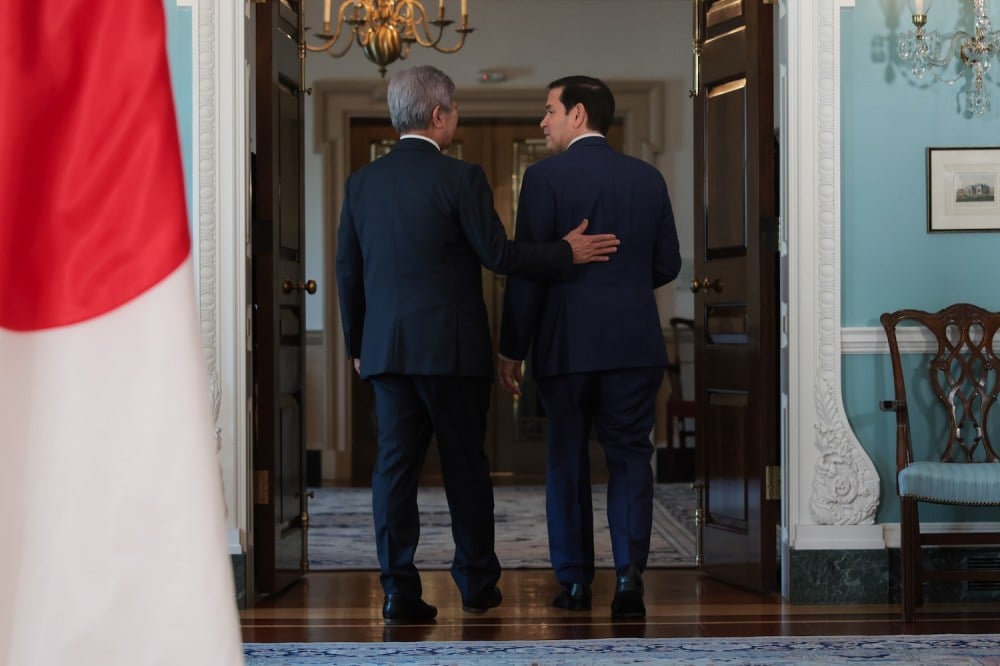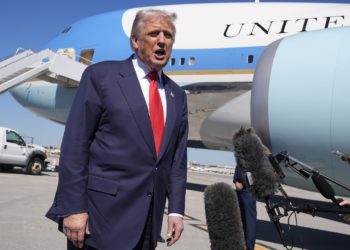A flurry of summit meetings assembled leaders from the Indo-Pacific last week, from Kuala Lumpur to Tokyo to Gyeongju. But questions linger over one other summit meeting that was planned for this month. This year is India’s turn to host the summit meeting of the Quad, an informal grouping that brings together Australia, India, Japan and the United States; the Quad started in 2007 and lasted until 2008, and was revived during U.S. President Donald Trump’s first term. But after U.S.-India bilateral relations soured this past summer, Trump had reportedly been reluctant to attend. Recent news of a possible trade deal may clear the way for the summit to proceed. The question over the summit’s timing, or if it will even take place, reflects deeper uncertainties over the Quad’s future.
Now more than ever, however, the Indo-Pacific region needs the four countries to work together. It faces a daunting range of security hazards, from unrelenting natural disasters, to unchecked Chinese coercion of neighbors, to an unfettered Chinese arms buildup to take control of Taiwan. As American credibility looks shaky, the risk of major war is rising.
Deterring a major war in Asia requires some combination of states with the requisite geographic advantages, economic and technological capacity, and military prowess to convince China that aggression is unlikely to succeed. It needs, in other words, the Quad. But the Quad’s old patterns of cooperation, designed to build regional states’ capacity and win their trust, will not do. The group has an imperative—and indeed an opportunity—to refocus on a new agenda centered on coordinated strategic mobilization among themselves. Instead of trying to cure cancer or install new solar panels on remote islands, Quad countries should focus on their industrial capacity, national resilience, military cooperation, and senior defense consultations.
Such mobilization and coordination would certainly benefit from trust among the Quad partners, but it can accelerate even if Washington’s politics remain volatile. The partners can continue to thicken working-level connections that can withstand periodic disruptions in political trust. Mobilization also does not imply any commitment to fight in a hypothetical war. Australia, India, Japan, and the United States do not share identical policy settings or even identical perceptions of the challenges posed by China. They do, however, each have an interest in hardening their defenses against Chinese aggression.
After a decade of abeyance, the first Trump administration revived the Quad in 2017 as the champion of a “free and open Indo-Pacific”—an alternative to a China-dominated region. The Biden administration embraced it and elevated it to summit level, with a more expansive, almost chaotic agenda, spanning maritime security, to climate change, to STEM education fellowships.
Predictably, the second Trump administration was skeptical about much of that agenda. Nonetheless, it hosted a meeting of Quad foreign ministers the very next day after Trump’s inauguration, in a clear signal of the importance that the new administration placed on the Indo-Pacific region and its preferred constellation of partners. However, the “America First” foreign policy quickly showed scant regard for development aid or the painstakingly cultivated architecture of international order. So, naturally, Washington was no longer interested in the Quad’s old paradigm as the provider of “international public goods” that help regional states manage emerging transnational challenges.
The Quad tried to redefine its role accordingly. At the next meeting of Quad foreign ministers in July, the group unveiled a new streamlined set of four priorities: maritime and transnational security; economic security; critical and emerging technology; and humanitarian assistance and emergency response. Senior representatives, like Indian External Affairs Minister S. Jaishankar, made it clear that the Quad’s mission was now focused on building the partners’ capabilities and mitigating their vulnerabilities rather than providing for the region.
These best-laid plans, however, were rocked by a summertime rupture in U.S.-India bilateral relations. A string of unexpected provocations from the White House, including the imposition of new punitive tariffs vaporized New Delhi’s trust in the United States. At the Shanghai Cooperation Organization summit, Indian Prime Minister Narendra Modi chortled conspicuously for the cameras with Chinese President Xi Jinping and Russian President Vladimir Putin. But India still invested in more substantial cooperation with other Quad partners: Modi signed a long raft of new bilateral agreements with Japan, and his defense minister did likewise with Australia.
Even though the U.S.-India relationship will likely stabilize, the damage to American credibility will be irreversible. Meanwhile, reports claiming the new U.S. National Defense Strategy will prioritize the Western Hemisphere, as well as the Trump administration’s open-ended military build-up off Venezuela, call into question its focus on countering China in the Indo-Pacific.
Allowing the Quad to wither, however, would be a grave mistake for all parties.
The Indo-Pacific remains more prone than any other to natural disasters, and the Quad is developing and exercising the most effective emergency response capabilities. Many smaller regional countries remain endangered by illegal fishing, piracy, and smuggling, and the Quad is supplying them with critical information to monitor their waters. Guarding against these threats, and protecting the region’s undersea cables, for example, is not only intrinsically important, but it also limits China’s ability to deepen its global influence.
More seriously, the region also faces a rapidly rising risk of conflict, especially between the United States and China. Beijing has accelerated its coercion against Taiwan with an increasing drumbeat of aerial and naval exercises, and against the Philippines with increasingly violent encounters at sea. The Chinese military also continues to taunt and threaten Quad partners such as India and Australia—notwithstanding recent diplomatic niceties with both countries—with unsafe behavior and shows of force.
Beijing’s military buildup, both conventional and nuclear, continues apace and is nearing important capability milestones that may embolden it to act even more aggressively. Even if the region escapes a major war over Taiwan, China’s expansionist goals suggest that its coercion against its neighbors—and the risk of escalation to conflict—will persist, especially as it becomes more heavily armed.
Mitigating that risk requires convincing Beijing’s leaders that they cannot advance their interests through the force of arms. Today, it is apparent to Beijing that any opposition it might face is unprepared and disunited. But concerted action from Quad countries could change China’s calculus.
The countries of the Quad are a uniquely formidable combination. Its members each have large economies and industrial bases—together representing around 35 percent of global GDP (compared to China’s 17 percent). They have thriving high-tech ecosystems that are increasingly connected to each other through a series of bilateral or trilateral initiatives such as TRUST, INDUS-X, and AUKUS. They have highly capable militaries—together representing around 45 percent of global military spending (compared to China’s 12 percent)—and a geographic spread around China that would severely complicate any Chinese military planning.
Their latent capacity is enormous. Their task now is to convince China that they have the strategic stamina to prevail in what could be a long and brutal conflict. The United States cannot do this alone; its partners must act decisively and collectively. This requires strategic mobilization and coordination.
As I and my co-authors argued in a recent Stanford University report, the Quad partners should prioritize four areas of effort.
First, they should build their defense industrial capacity: stockpiling weapons to create a ready arsenal as well as building infrastructure and processes for production that can adapt later during wartime. The production of exquisite munitions is painfully slow and expensive. But a range of alternatives, including modular systems such Quicksink bomb kits or lower-tech drones, can be more easily mass produced, and, importantly, jointly produced for greater scale, including by newer partners such as India.
Second, they should invest in national resilience, with greater redundancies in critical infrastructure and reserves of energy, medicine, critical minerals, and other vital supplies. In a recent example, the United States has signed deals with Australia and Japan for the production, stockpiling, and supply of critical minerals, thereby mitigating their dependence on Chinese supplies.
Third, they should build the enabling foundations of military power—that is, elements of capability that are mission-agnostic, so they can be used equally for humanitarian assistance as for conventional combat. These enabling foundations include the high-fidelity data and secure communications central to modern warfare; arrangements to repair and resupply each other’s equipment; greater development of facilities; and access to each other’s bases. Consider, for example, P-8 maritime patrol aircraft. Australia, India, and the United States all operate variants of the aircraft, but their collective capability to track and target Chinese submarines—or, equally, to find missing fishing boats—would increase geometrically if their aircraft all had secure data links and could more routinely operate from each other’s bases at Port Blair and the still-to-be-upgraded Cocos (Keeling) Islands.
Fourth, they should deepen defense consultations to coordinate their plans. Many of these mobilization priorities require decisions and authorities within each partner’s defense establishments, which are not yet involved in Quad deliberations. Ideally, this should be done at the ministerial level to create bureaucratic requirements to deliver results—even if it lies outside the official Quad-badged processes.
Much of the work to redefine the group could be done individually by each Quad country. Other projects may be best tackled bilaterally or trilaterally; and even when all Quad countries may be involved, they do not need to invoke the Quad brand, perhaps to allay suspicions in a region that is skittish about strategic competition.
The Quad has long recognized the importance of not alarming Southeast Asian countries, lest they gravitate further toward China. For that reason, the Quad should not abandon many of its current projects on, for example, maritime domain awareness or undersea cables, which promise long-term security gains for the region. Quad countries should be careful to note that their individual or coordinated mobilization in no way impinges on existing institutions such as the Association of Southeast Asian Nations. If anything, it may allow some states such as the Philippines, Singapore, or South Korea to open new avenues of mutually beneficial strategic cooperation with Quad partners.
The United States has a particular role to play. After months of policy disruptions, its partners crave signs of stability. Even issuing planning guidance—on defense industrial base mobilization, for example—would encourage partners to make their own investments. Sharing U.S. defense technology with Quad partners and easing export restrictions would enable those partners to carry more of the defense-spending burden. The return on investment would be spectacular.
Granted, deepening cooperation is difficult when national policy settings are so volatile. The Trump administration’s tariffs and transactionalism have been especially damaging to international partnerships. But coordinated mobilization is based firmly on each partner’s self-interest, whether to prepare national defenses against aggression or national resilience against other major hazards. With bold leadership in Washington and other capitals, these four like-minded powers could deliver on Jaishankar’s promise of building their own capacities and mitigating their vulnerabilities.
In fact, in today’s political climate, a new focus on strategic mobilization may actually be the most realistic grounds for coordinated action. It is certainly a more viable organizing principle than the old paradigm of international public goods. If the Quad partners can agree on anything, it is that the Indo-Pacific cannot be free and open without also being secure.
The post The Quad Is Dead, Long Live the Quad appeared first on Foreign Policy.




